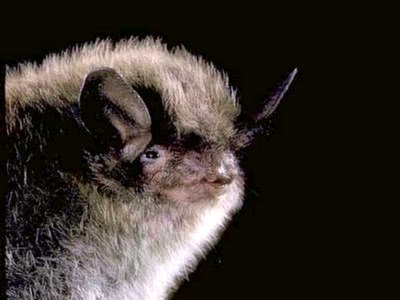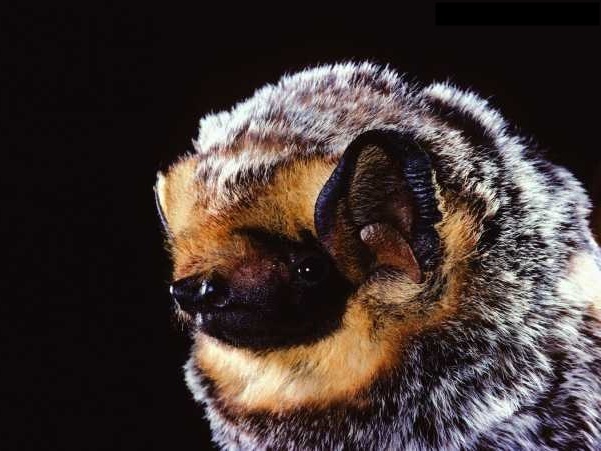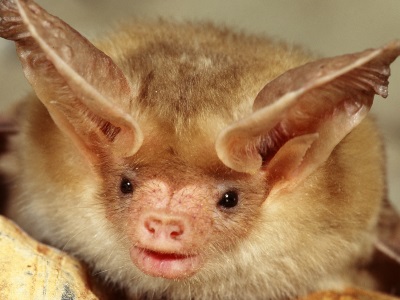 credit: merlintuttle.org
credit: merlintuttle.org
Little Brown
Myotis lucifugus
Common Name: little brown
Family: Vespertilionidae
Genus: Myotis
Species: lucifugus
Historically, the little brown myotis was abundant throughout forested areas of the U.S. as far north as Alaska. It ranges from Alaska to Labrador and Newfoundland (Canada), south to southern California, northern Arizona, and northern New Mexico. In the West it is found mainly in mountainous and riparian areas in a wide variety of forest habitats; from tree-lined xeric-scrub to aspen meadows and Pacific Northwest coniferous rain forests. This species is especially associated with humans, often forming nursery colonies containing hundreds, sometimes thousands of individuals in buildings, attics, and other man-made structures.
In addition to day roosts in tree cavities and crevices, little brown myotis seem quite dependent upon roosts which provide safe havens from predators that are close to foraging grounds. Little brown myotis forage over water where their diet consists of aquatic insects, mainly midges, mosquitoes, mayflies, and caddisflies. They also feed over forest trails, cliff faces, meadows, and farmland where they consume a wide variety of insects, from moths and beetles to crane flies. Individuals can catch up to 1,200 insects in just one hour during peak feeding activity.
Today, this species has been heavily impacted by the devastating disease, white-nose syndrome. Once abundant throughout eastern North America, the species is now uncommon throughout much of its eastern range.
 credit: merlintuttle.org
credit: merlintuttle.org
Hoary
Lasiurus cinereus
Common Name: hoary bat
Family: Vespertilionidae
Genus: Lasiurus
Species: cinereus
Hoary bats are one of America's largest and most handsome bats. With their long, dense, white-tipped fur, they have a frosted, or hoary, appearance. Humans rarely get the chance to see these magnificent bats; they are not attracted to houses or other human structures, and they stay well-hidden in foliage throughout the day. They typically roost 10-15 feet up in trees along forest borders. In the summer, hoary bats don't emerge to feed until after dark, but during migration, they may be seen soon after sundown. They sometimes make round trips of up to 24 miles on the first foraging flight of the night, then make several shorter trips, returning to the day roost about an hour before sunrise. Between late summer and early fall, they start their long journey south, migrating to subtropical and possibly even tropical areas to spend the winter.
Traveling in waves, they are often found in the company of birds, who also migrate in groups. For the rest of the year, however, hoary bats remain solitary. They are among the most widespread of all bats, found throughout most of Canada and the United States and south into Central and South America. The hoary bat is Hawaii's only native land mammal. Stray individuals have been found from Iceland to Orkney Island as well as in Bermuda and the Dominican Republic.

Big Brown
Aenean ornare velit lacus, ac varius enim lorem ullamcorper dolore. Proin aliquam facilisis ante interdum. Sed nulla amet lorem feugiat tempus aliquam.

Silver Haired
Aenean ornare velit lacus, ac varius enim lorem ullamcorper dolore. Proin aliquam facilisis ante interdum. Sed nulla amet lorem feugiat tempus aliquam.
 credit: merlintuttle.org
credit: merlintuttle.org
Pallid
Antrozous pallidusi
Common Name: pallid bat
Family: Vespertilionidae
Genus: Antrozous
Species: pallidus
The pallid bat is known for its unique habit of feeding almost entirely from the ground. Unlike most other North American bats, this species captures little, if any, prey while in flight. With its huge ears, it can detect insects simply by listening for footsteps, and it can respond accurately to a split-second sound from up to 16 feet away.
After swooping down upon its prey, the pallid bat carries the insect to a convenient perch to consume its meal. Its most common prey include crickets, beetles, grasshoppers, and even scorpions. The pallid bat is actually immune to a scorpion's sting! Pallid bats roost in rock crevices, buildings, and bridges in arid regions. They are found from Mexico and the southwestern United States north through Oregon, Washington, and western Canada.

Western Small-footed
Aenean ornare velit lacus, ac varius enim lorem ullamcorper dolore. Proin aliquam facilisis ante interdum. Sed nulla amet lorem feugiat tempus aliquam.

Long-legged
Aenean ornare velit lacus, ac varius enim lorem ullamcorper dolore. Proin aliquam facilisis ante interdum. Sed nulla amet lorem feugiat tempus aliquam.

Mexican Free-tailed
Aenean ornare velit lacus, ac varius enim lorem ullamcorper dolore. Proin aliquam facilisis ante interdum. Sed nulla amet lorem feugiat tempus aliquam.

Western Pipistrelle
Aenean ornare velit lacus, ac varius enim lorem ullamcorper dolore. Proin aliquam facilisis ante interdum. Sed nulla amet lorem feugiat tempus aliquam.

Yuma
Aenean ornare velit lacus, ac varius enim lorem ullamcorper dolore. Proin aliquam facilisis ante interdum. Sed nulla amet lorem feugiat tempus aliquam.
 credit: merlintuttle.org
credit: merlintuttle.org




